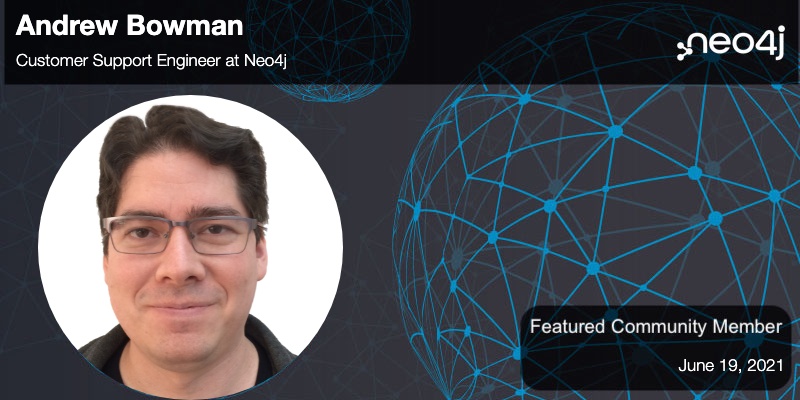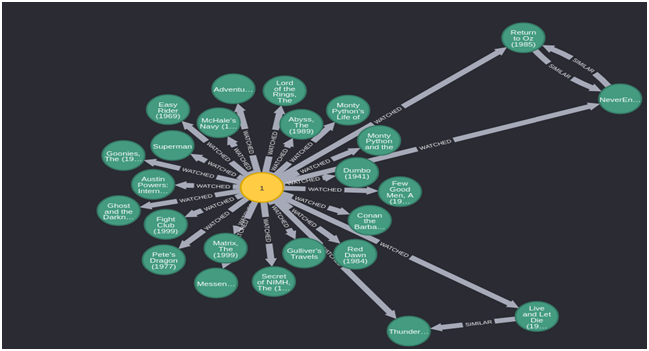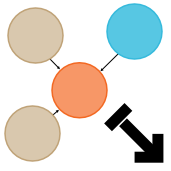This Week in Neo4j – Recommendations, Shakespeare, Graphyx, AuraDB Free Tier, Dungeons and Dragons, GraphSAGE, NODES 2021

Curriculum Developer at Neo4j
6 min read

Hello, everyone!
NODES 2021 has come and gone! It was a very successful online developer conference for us.
We hope you were able to attend, but if not, we will be posting links to the recordings soon.
We thank all of the speakers who presented.
The week we’re featuring Andrew Bowman as our most valued Neo4j Community Member.
If you have been on our forum or chat sites, you have seen how much he helps the community.
Atul Shukla published an article that describes how he used multiple data sources to create a movie recommendation system using Neo4j.
Rick Van Bruggen decided to explore the Shakespeare Kaggle data by loading it into Neo4j and analyzing the data.
You can take a look at the newly-released Alteryx Connectors for Neo4j written by Thomas Larsen.
Guy Royse did a nice job of comparing and contrasting SQL and Cypher in his presentation at the All Things Open conference last year.
Sefik Ilkin Serengil explains a simple example of Graph Embeddings using GraphSAGE and how it is useful for facial recognition.
Neo4j has announced the Early Access of Neo4j AuraDB Free, a cloud instance that is free and does not expire like a Neo4j Sandbox does.
Many folks were on a waiting list and we are happy to enable them to use AuraDB Free.
Finally, we share a link to the opening and closing Keynote addresss for NODES 2021 given by Emil Eifrem and Jim Webber. In addition, we provide the links to the pre-NODES training session recordings.
Featured Community Member: Andrew Bowman
This week’s featured community member is Andrew Bowman.

Andrew Bowman – This Week’s Featured Community Member
We are way past due in recognizing Andrew as a person in the Neo4j Community who has helped a tremendous number of users.
No matter how “snarly” a question is, Andrew digs into it and resolves the problem at hand.
He knows Cypher inside and out and is my go-to person when I need a good explanation of how queries work in Cypher.
He has presented at NODES 2020 and you will always see him answering questions on our Community and Discord sites.
His “day job” is with the Neo4j Customer Support team where he supports our Enterprise users.
He has also written many informative and timely Knowledge Base articles to help our user community.
We thank Andrew for his dedication to the Neo4j Community!
A Recommendation System Using a Graph Database

Atul Shukla from 47Billion wrote an article about his experience creating a recommendation system for movies.
He used the data provided by The Movie DB and OMDb API.
As with any import of CSV data, he explains how he needed to clean up the data before loading it.
Then he describes the graph data model he used to create the nodes and relationships in the graph.
And finally, he shows some of the Cypher queries he used against the graph to implement the recommendations.
Kudos to Atul for sharing his experiences.
Network Analysis of Shakespeare’s Plays

Rik Van Bruggen from Neo4j did some interesting loading of a Kaggle dataset with all of Shakespeare’s plays.
Then, he was able to analyze the data to uncover the hidden networks.
In his blog, he describes how he prepared the database for loading, loaded the data, and then, most importantly, refactored the graph to give it a structure that lends itself to exploration.
He then shows how he explored the data in Bloom.
And finally, he explains how he used some graph algorithms to further analyze the data.
Graphyx: Alteryx Connectors for Neo4j

Thomas Larsen has just published his Alteryx Neo4j Connectors, Graphyx.
Graphyx can be used by Alteryx developers who want to import Cypher queries into Alteryx workflows, export Alteryx data to a graph, or delete data from the graph.
Thomas used the Alteryx Go SDK and the Neo4j Go driver to build the connectors,
as well as Flutter for the UI.
Announcing Early Access of Neo4j AuraDB Free

Many, many developers have been patiently waiting for AuraDB Free. It is now available!
AuraDB Free is a free cloud instance of Neo4j (latest release) that you can use for your development projects and demonstrations.
Unlike a Neo4j Sandbox, it does not expire!
There are limitations you should be aware of:
- You can have one user database.
- The maximum number of nodes is 50K and maximum number of relationships is 175K.
- Because it is a cloud instance, you cannot modify the configuration (neo4j.conf).
- You cannot place any files (for example, CSV files or Cypher files) in the filesystem of the instance.
- It will have the APOC plugin, but it will NOT have the GDS Library or GraphQL plugins available.
We will be adding videos that will help you get started with Neo4j AuraDB Free Tier. Here is a video for Getting Started with AuraDB Free.
And here is a video that shows you how to import CSV data into your AuraDB Free database.
You can load an example data dump file data or Neo4j Sandbox dump file into your AuraDB Free database.
Note that the dump file must be the same major version as the database.
Many of the GraphAcademy developer courses can be taken using your AuraDB Free database.
You can learn more about Neo4j AuraDB here. When you create an AuraDB account, the Free database is available to you.
Dungeons, Dragons, and Graph Databases

Calling all Dungeons and Dragons fans! Guy Royse, a developer advocate at Redis Labs, presented an hour-long talk at the All Things Open conference last year that provides a great introduction to the Property Graph Model.
It goes into how to analyze the data using a relational model and compares it to a graph data model.
He shows queries in SQL and then the same query in Cypher.
What he leads the user to, however, is the benefit of using a graph over tables, especially when you want to look at variable length paths between entities.
Although he uses ReditGraph as the underlying database, it is a great way to see the benefits of graph databases and Cypher for querying the graph.
Graph Embeddings in Neo4j with GraphSAGE

Sefik Ilkin Serengil has published this article that describes how he uses GraphSAGE to train the network for Game of Thrones data.
GraphSAGE is one of three ways to embed graphs so you can perform deeper analysis of the data.
GraphSAGE is implemented to create neural networks within your graph.
He also points to another presentation that he did showcasing a facial recognition application using some of the same techniques.
NODES 2021: Our Third Annual Online Neo4j Developer Conference

We had a very successful conference this year that included a Pre-NODES week of hands-on training sessions given by our Developer Relations team members.
You can watch these recorded hands-on training sessions here:
- Hands-on Introduction to Neo4j (Lju Lazarevic)
- Hands-on with Neo4j AuraDB Free Tier (Jennifer Reif)
- Getting Started with Neo4j Bloom (Lju Lazarevic)
- Building GraphQL APIs with the Neo4j GraphQL Library (William Lyon)
- Creating a Knowledge Graph with Neo4j: A Simple Machine Learning Approach (Clair Sullivan)
Next week, we will be posting the links for the NODES 2021 sessions that were recorded.
Tweet of the Week
My favorite tweet this week was by Rik Van Bruggen:
If you care about insights.
If you care about insights based on data.
If you care about insights based on data from databases.
If you care about new insights based on interesting data from native graph databases.One word: #NODES2021
One link: https://t.co/4WVazE4fx8#neo4j— Rik Van Bruggen (@rvanbruggen) June 16, 2021
Don’t forget to RT if you liked it too!








